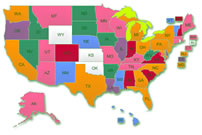If you are in the market for a new car, you may have been tempted by offers of “low, low monthly payments” if you lease. Leasing has its advantages: With a lease, you can expect to make little or no down payment and make lower monthly payments. At the end of the lease period, you don’t have to worry about the trade-in or sale of the used car. You can just turn back the keys to the leasing company, and walk away-literally, since you won’t have a car. Or you can sign a lease on a new vehicle, and drive away instead.
That leads us to the major disadvantage of leasing a car. Granted, your monthly payment will be less each month, but at the end of the lease period, you don’t own anything. It’s like leasing an apartment rather than buying a house. If you want to continue driving the same car, you must purchase it from the leasing company for its current market value. Otherwise, you’ll have to lease or buy a new vehicle.
Leasing a car has other disadvantages. You’ll need a good credit rating to lease a car, but even a so-so rating will allow you to purchase one. When you lease, you must purchase special “gap” insurance that will cover the remaining lease payments on the leased car if it is wrecked or stolen. And at the end of the lease period, you may be charged for miles you drove in excess of the maximum specified in your lease, and you also may be charged for excess wear and tear on the car.
To decide whether or not to lease, use this handy worksheet. Compare the result on line 7 for both scenarios, and choose the option with the lowest cost.
To Lease or Not to Lease
| COST TO PURCHASE | ||
| 1. Down payment | ||
| 2. Monthly payment | ||
| 3. Times length of the loan | x | |
| 4. Total payments | = | |
| 5. Sales tax and out-of-pocket expenses | ||
| 6. Estimated value of the car after all payments are made | – | |
| 7. Total cost of purchasing the car (1 + 4 + 5 – 6) |
||
| COST TO LEASE | ||
| 1. Monthly payment | ||
| 2. Times length of the lease | ||
| 3. Total lease payments | x | |
| 4. Up-front costs, if any | = | |
| 5. Disposition fees, if any | ||
| 6. Cost of gap insurance | ||
| 7. Total cost of leasing the car (3 + 4 + 5 + 6) |
||
If leasing looks like the better option, proceed with caution. Car companies have many ways of making the finances so complicated that you can’t tell if you’re getting a good deal or losing your shirt. If you do decide to lease, go through the proposed lease step-by-step and make sure it meets the criteria below.
- A lease term that corresponds to the length of time you’ll want to keep the car.
- No up-front “capital cost reduction” (read “down payment”).
- Closed-end lease so you won’t be charged if the car is worth less than the estimated residual value.
- Mileage limit that corresponds to your driving habits.
- No extra charge for moving the vehicle out of state.
- Guaranteed-price purchase option.
- Security deposit not in excess of one monthly payment.
- No up-front charge for sales tax.
- Payments that are less than you would pay on a car loan. Comparison-shop for lowest costs.
- No early termination fee.
- Ability to incorporate the cost of extra miles into the monthly payment at a reduced cost.
- Refund provision for cost of extra miles you buy but don’t drive.









